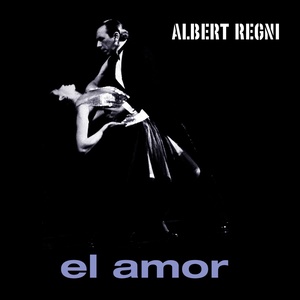
- 歌曲
- 时长
简介
Albert Regni: El Amor (Sons of Sound SSPCD005) ASTOR PIAZZOLLA My introduction to the music of Astor Piazzolla began in 1996 with a transcription of his "Histoire du Tango" by Claude Voirpy for saxophone quartet. I immediately felt its affinity for the instrument, along with the charm and breadth of its styles. The cosmopolitan flair and distinctive Argentine influence, combined with the harmonies of American jazz, have justly contributed to the composer’s worldwide popularity and success. After a visit to Argentina that same year, I became familiar with Piazzolla’s published music and excitedly began making arrangements for saxophone with various combinations of instruments. In the pieces selected here, my intention was to reflect the saxophone’s compatibility with the string trio and the tango. Just as Piazzolla’s "Histoire du Tango" took the tango from clubs and bordellos to the concert hall, these arrangements are intended to be formally presented, for the ear rather than the feet. "La Evasion" is a high-energy movement taken from a collection entitled Suite Lumiere (“Light”). The ‘evasion’ — of love? — is represented by a variety of agile, darting melodies in the saxophone and violin, along with a passionate, slow plea from the cello. "El Amor" presents a languid viola line as the underpinning of a Piazzolla melody (also from Suite Lumiere) soulfully yearning for love. "Tango del Diablo" has many of the sinister moods associated with a diabolical force. "Oblivion" stands as one of the most haunting, magical melodies of any musical style and makes one long to tango. Finally, "Todo Buenos Aires" represents the vitality and excitement of one of the world’s greatest cities. — Albert Regni, May 1999 PIERRE MAX DUBOIS "Feu de Paille" ("Straw Fire") is a colloquialism used in France to suggest a short, intense passion. The unusual combination of violin and saxophone displays Dubois’ crafty compositional skills, bringing together two instruments with remarkable technical and dynamic possibilities. — Albert Regni, April 1999 BERNARD HOFFER After a spirited dinner conversation on the advantages of playing cello or saxophone I was stimulated to write a piece for both instruments. I later presented "Invention in a Baroque Style" to Dorothy Glyde, the cellist, on the occasion of her 75th birthday. Later that year came "Scarlattian Sonata" for saxophonist Raymond Beckenstein, on his 70th birthday. This piece is for violin and soprano sax, both of which Ray plays. Finally, to round out the cycle, for Albert Regni’s 60th birthday came "Arietta in a Bachian Manner." I had thought about writing several more "birthday presents," but before the occasions could present themselves, Albert Regni planned a recital with string trio. I therefore wrote the other two pieces, "Aria Maraisienne" and "Giga à la Vivaldi," using all the string instruments to unify the suite. The compositions are written as stylistic paraphrases reminiscent of 17th- and 18th-century composers, though not specific to any one style. — Bernard Hoffer, April 1999 ALBERT REGNI, the founder and leader of The American Saxophone Quartet, is Principal Saxophonist with the New York Philharmonic, Metropolitan Opera, and New York City Ballet Orchestras. He is also Professor of Saxophone at The College of New Jersey.


